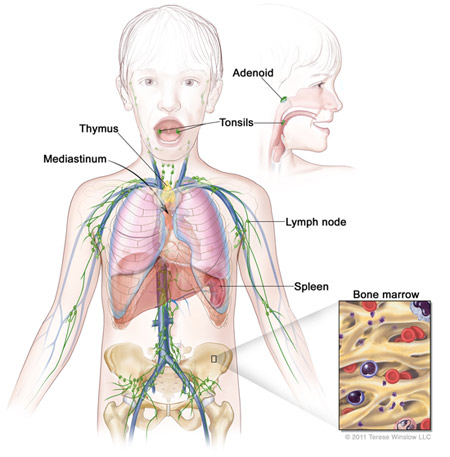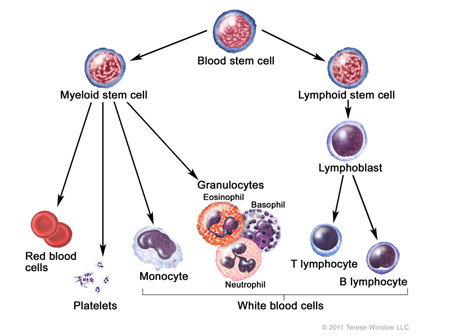Hodgkin Disease
Hodgkin disease is a cancer of the lymphoid system. The lymphoid system is made up of various tissues and organs, including the lymph nodes, tonsils, bone marrow, spleen, and thymus. These organs produce, store and carry white blood cells to fight infection and disease.

Hodgkin disease accounts for 5% of cancers diagnosed in children under age 15 in the United States. While the disease has been reported in infants and very young children, it rarely occurs in children under five. The number of cases increases significantly in the second decade of life, making it most common in teenagers,comprising 16% of cancers in adolescents.
Most patients who have Hodgkin disease experience swollen lymph nodes, called lymphadenopathy. These nodes are usually larger than those that occur with common infections, and do not respond to standard treatments like antibiotics. The affected lymph nodes are usually found in the neck or above the collar bone, and less commonly under the arms or in the groin. The lymph nodes are most often painless, firm, rubbery, and movable in the surrounding tissue.

Poor appetite, weight loss, night sweats, fever, a sense of ill-feeling and fatigue can also be experienced by children with Hodgkin disease. They are "systemic" symptoms with a more generalized affect on the entire body. Itching (pruritus) is another symptom in patients with Hodgkin disease. This can be mild or severe, and tends to occur more often in patients with advanced disease. Pruritus is less commonly found in children.
The causes of Hodgkin disease are unknown. Studies that examine the rates of disease within populations, called epidemiologic studies, suggest some possible factors that may be at work. However, there is no evidence that any one particular factor is responsible for this disease.
Viruses and Bacteria
There may be a relationship between viral infection and Hodgkin disease, although a virus alone does not cause the disease. The Epstein Barr virus (EBV), the virus responsible for mononucleosis, is seen in the tumor tissue of 20%-30% of patients, but is not known to be the cause of the disease. Most people are exposed to EBV by the time they are adults and most do not get Hodgkin disease, so the role of EBV still needs to be studied.
Genetics and Environment
Studies have reported an increased risk of disease in close relatives of patients with Hodgkin disease, especially same-sex siblings. Although the risk is two to five fold higher for siblings, the likelihood that a sibling will get Hodgkin disease remains extremely low. The clustering of cases of Hodgkin disease within families and in certain ethnic groups may suggest a genetic predisposition to the disease.
Immune System Deficiencies
Hodgkin disease is more common in people whose immune system is weakened. Immune deficiency can be caused by genetic conditions or can be acquired. It may also occur in individuals infected with human immunodeficiency virus (HIV, the cause of AIDS).
Last updated September, 2011
Newly Diagnosed with Hodgkin Disease
In Treatment for Hodgkin Disease
After Treatment for Hodgkin Disease








